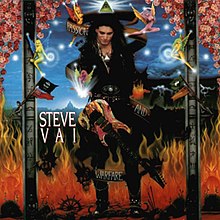Passion and Warfare
| Passion and Warfare | ||||
|---|---|---|---|---|
 |
||||
| Studio album by Steve Vai | ||||
| Released | September 1990 | |||
| Recorded | The Mothership | |||
| Genre | Instrumental rock | |||
| Length | 53:15 | |||
| Label | Relativity/Epic | |||
| Producer | Steve Vai | |||
| Steve Vai chronology | ||||
|
||||
| Professional ratings | |
|---|---|
| Review scores | |
| Source | Rating |
| AllMusic | |
Passion and Warfare is the second studio album by guitarist Steve Vai, released in September 1990 through Relativity and Epic Records. It has been certified Gold by the RIAA. It was written based on a series of dream sequences that Vai had when he was younger, and in the guitar music book of the album, Vai sums it up as "Jimi Hendrix meets Jesus Christ at a party that Ben Hur threw for Mel Blanc". It was all recorded in The Mothership studio at his home in the Hollywood Hills, a 1,600-square-foot (150 m2) building in which his guitar parts for Whitesnake's 1989 album Slip of the Tongue were also recorded. As such, Whitesnake frontman David Coverdale has small spoken parts on Passion and Warfare.
Vai states that planning the album started as early as 1982, but was shelved after joining the David Lee Roth band and not picked up again until parting ways with Roth in 1989. Vai utilized many unusual recording techniques on the album. For what would come to be one of his most popular songs to date, "For the Love of God", he fasted for ten days and recorded the song on the fourth day of the fast. "Blue Powder" was originally recorded in 1986 as a showcase track for Carvin, using their X-100B amplifier, and given away with Guitar Player magazine in flexi disc format. Vai was introduced to Carvin by his mentor Frank Zappa, who had also used the X-100B. The drums were subsequently re-recorded for the album.
The equipment used to record Passion and Warfare was: Ibanez JEM and Universe guitars; Charvel Green Meanie guitar; Marshall JCM900 and Carvin X-100B amplifiers; ADA MP-1 preamplier; Boss DS-1 distortion pedal; Eventide H3000 harmonizer; Lexicon 480L.
...
Wikipedia
